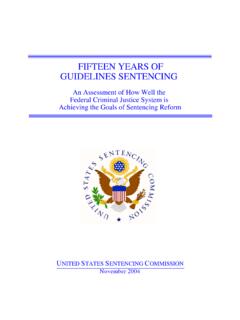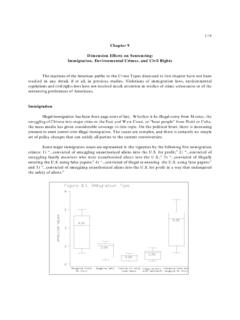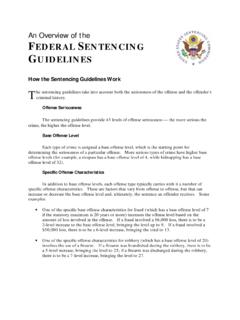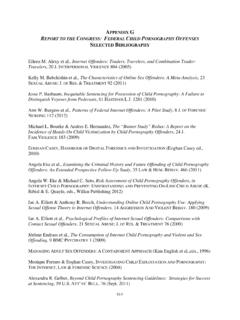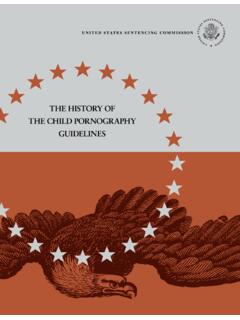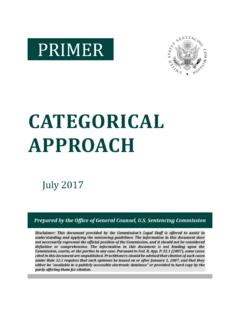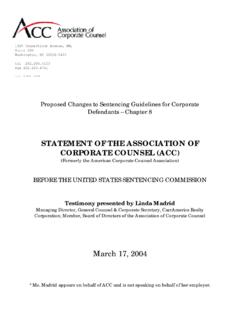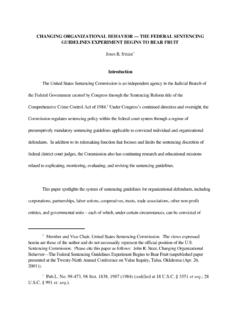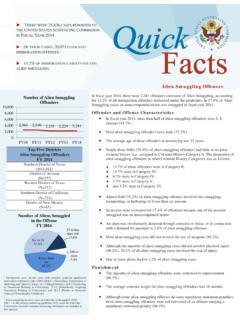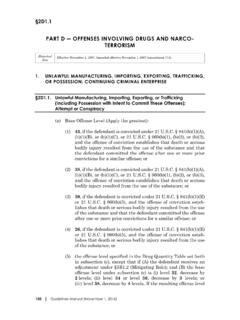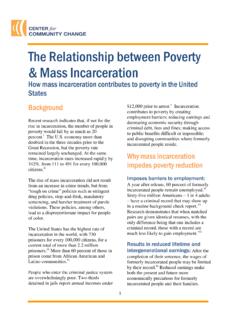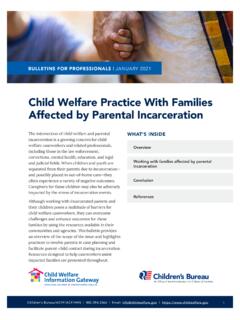Transcription of Federal Alternative-to-Incarceration Court Programs
1 Federal Alternative-to-Incarceration Court ProgramsUNITED STATES SENTENCING COMMISSIONW illiam H. Pryor, Jr. Acting ChairRachel E. BarkowCommissionerCharles R. BreyerCommissionerDanny C. ReevesCommissionerZachary BolithoEx Officio J. Patricia Wilson SmootEx OfficioKenneth P. Cohen Staff DirectorSeptember 2017 United States Sentencing CommissionOne Columbus Circle, , DC of ContentsI. The Development of Alternative-to-Incarceration Court Programs During the Last Three Alternative-to-Incarceration Programs in the State Alternative-to-Incarceration Programs in the Federal The Operation of Alternative-to-Incarceration Court Programs Within the Current Legal Framework of Federal Overview of the Sentencing Reform Act of Federal Alternative-to-Incarceration Court Programs in Light of Booker and its Social Science Questions Concerning Federal Alternative-to.
2 incarceration Court Use of Social Science in Designing and Evaluating Federal Alternative-to-Incarceration Court Evaluation of Federal Alternative-to-Incarceration Court Relevance of State Problem-Solving Court V. 1 5 5 7 14 33 33 35 45 46 47 52 55 57 93 Federal Alternative-to-Incarceration Court ProgramsUnited States Sentencing Commission6 Federal Alternative-to-Incarceration Court Programs1 During the three decades that it has been in existence, the United States Sentencing Commission (Commission)1 repeatedly has considered the important issue of when an alternative to incarceration is an appropriate sentence for certain Federal defendants.
3 The original 1987 Guidelines Manual provided for alternative sentencing options such as probation for certain low-level Federal offenders,2 and the Commission thereafter amended the guidelines on several occasions to increase the availability of alternative sentences as sentencing Despite these amendments, the rate of alternative sentences imposed in cases governed by the sentencing guidelines has fallen steadily during the past three decades,4 including after United States v. Booker,5 and Gall v. United States,6 which increased Federal judges discretion to impose alternative sentences. In recent years, the Commission has prioritized the study of alternatives to incarceration as a sentencing Many Federal district courts around the country, with the support of the Department of Justice (DOJ), have begun creating specialized Court Programs to increase the use of alternatives to incarceration for certain types of offenders, most commonly for those with substance use disorders.
4 These Programs have developed independently of policy decisions of both the Commission and the Judicial Conference of the United Commentators, including judges who have presided over these Court Programs , have urged the Commission to amend the Guidelines Manual to encourage such Programs and provide the option of a downward departure to a non- incarceration sentence for defendants who successfully participate in them and who otherwise would face imprisonment based on their guideline sentencing As part of its recent priority concerning alternatives to incarceration , the Commission has studied these emerging Court I. IntroductionBrent E. Newton, Staff DirectorUnited States Sentencing Commission2programs. The Commission s study has been qualitative rather than quantitative at this juncture because of a lack of available empirical data about the Programs .
5 In late 2016 and early 2017, Commission staff visited five districts with established Programs , interviewed program judges and staff, and observed proceedings. On April 18, 2017, the Commission conducted a public hearing about such specialized Federal Court Programs , at which the Commission received testimony from experts on state drug courts and other problem-solving courts as well as from Federal district judges who have presided over three of the more established Alternative-to-Incarceration Court This publication summarizes the nature of these emerging Federal Alternative-to-Incarceration Court Programs and will highlight several legal and social science issues relating to Part II defines key terms and concepts, discusses the history of Alternative-to-Incarceration Court Programs , which originated in the state courts nearly three decades ago, and then specifically describes the types of specialized Federal Court Programs that have been created in recent years.
6 Part III discusses legal issues related to the Federal Court Programs , including how they fit within the legal framework created by the Sentencing Reform Act of 1984 (SRA) and modified by the Supreme Court in 2005 in Booker. Part IV identifies social science issues related to the Programs , including issues related to the efficacy and cost-effectiveness of the Federal Court Programs . Part V concludes by identifying several questions about the Federal Court Programs that policymakers and courts should consider in deciding whether, and if so how, such Programs should operate in the Federal criminal justice system in the future. Those questions include: How do the Programs fit within the legal framework created by the Sentencing Reform Act of 1984, which continues to apply in significant ways after Booker? Do the Programs , when not governed by a uniform national policy, result in unwarranted sentencing disparities, including demographic disparities?
7 Federal Alternative-to-Incarceration Court Programs3 Have Programs been designed and implemented to allow for meaningful outcome evaluations and cost evaluations? How do the Programs compare to regular sentencing options either imprisonment followed by supervised release or regular supervision by Federal probation officers with respect to promoting rehabilitation and reducing recidivism? Will the Programs either in their current small sizes or if taken to scale result in a cost savings compared to regular sentencing options?Some of these questions are not capable of being answered at this point due to the nascent nature of the existing Federal Court Programs . Not only are the Programs relatively new in the Federal system and only have graduated a small number of participants to date, they also have developed in a decentralized manner and differ from each other in significant respects.
8 Thus, they cannot yet be evaluated empirically to determine whether the Programs meet their articulated goals as effectively as, or more effectively than, traditional Federal sentencing and supervision options. The Commission thus recommends that existing Programs and any newly developed Programs include input from social scientists so that data may be properly collected to allow for a meaningful evaluation at a later time. United States Sentencing Commission4 Federal Alternative-to-Incarceration Court Programs5 DefinitionsAt the outset, it is important to define certain key terms and concepts. In this report, Alternative-to-Incarceration Court Programs refer to drug courts and other problem-solving courts or therapeutic courts ( , veterans courts, youthful offender courts) that began nearly three decades ago in the state courts and have emerged in the Federal judicial system in recent years.
9 Such problem-solving courts are generally based on the drug- Court model first developed in state Court in Miami, Florida, in That model involves a collegial rather than an adversarial judicial process, whereby a team consisting of one or more judges, prosecutors, defense attorneys, probation or pretrial services officers, a treatment provider, and sometimes others ( , a law enforcement officer, community mentors) works together on a regular basis (typically weekly or semi-monthly) with a group of defendants who all have a potentially treatable problem with an apparent nexus to their criminal conduct ( , substance use addiction, mental illness, or post-traumatic stress disorder [PTSD] from military service). Although defendants are individually supervised by pretrial services or probation officers outside of Court , the program team also interacts with the defendants as a group regularly in the courtroom and seeks to further the defendants treatment and rehabilitation.
10 In most Programs , a defendant must enter a guilty plea to a charge before proceeding with treatment and regular Court sessions. The typical program lasts for 12 to 24 months and involves regular group Court appearances, informal procedures, a focus on treatment (with multiple phases of treatment), sanctions and rewards, and an ultimate graduation for successful participants with concomitant reductions in sentences, typically to probation or a short time-served sentence followed by a period of supervision. Defendants who fail to complete the program s requirements are II. The Development of Alternative-to-Incarceration Court ProgramsUnited States Sentencing Commission6returned to the regular adversarial judicial process for disposition of their cases and often receive sentences of Alternative-to-Incarceration Programs as Distinct From Diversion ProgramsIt is important to distinguish Alternative-to-Incarceration Court Programs from related but distinct Programs that divert certain defendants who successfully complete treatment and other program requirements from the criminal justice system without a conviction.
